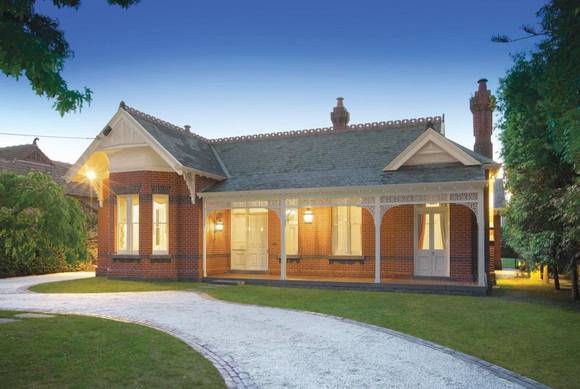| Back to search results » | Back to search page » |
|
Helenslea
Location181 Kooyong Road Toorak, STONNINGTON CITY LevelIncluded in Heritage Overlay |
|
Statement of Significance
What is significant? The single-storey bichromatic brick villa at No. 181 Kooyong Road, Toorak is a rare example of the architectural transition between the Victorian and the Federation styles which evolved in Melbourne around the turn of the nineteenth century. While the plan form is more Victorian as is the joinery, the plasterwork and mantels and grates have typical Edwardian detailing and appear to be highly intact. Interiors of this era are less numerous and are consequently rarer than Victorian or Federation interiors, moreover highly intact ones. On stylistic and historical grounds it is almost certainly a private commission undertaken by Public Works Department architect Samuel Edward Bindley for his later brother-in-law Walter Murray Buntine. Elements which are not of any significance are the front fence and gates, semi-circular driveway, side driveway and garage, rear addition (kitchen, informal dining, family room, laundry, store, bathroom and bedroom), swimming pool and cabana. How is it significant? No. 181 Kooyong Road, Toorak is of local historical and aesthetic/architectural significance. Why is it significant? Historically the subdivision and Walter Murray Buntine's houses are demonstrative of an early subdivision of part of one of the mansion estates, a phase of development which became widespread in the twentieth century and which lead to the breaking up and demolition of almost all of the great mansions which characterised the prestigious nature of the area. The private subdivision of the land from 'Ottawa' by Charles Officer, James Grice and Walter Murray Buntine, all prominent Melburnians, was one of the first expressions of the subdivision of the large estates and by the owner as compared more typically by development company. It is also a rare, almost unique, example of a villa development in the 1890s in this area where and when the mansions still dominated. It is also an example of a standard of accommodation appropriate for the professional and/or gentleman class in an area which was dominated by the mansions of the super-rich. It is also almost the last vestige of the late nineteenth century in Kooyong Road between Malvern and Toorak Roads and the immediate environs which were dominated by mansions and which is recalled in real-time by James Paxton. The architectural characteristics displayed at No. 181 Kooyong Road is a fusion of the characteristics of the Victorian and Federation styles, the latter which was evolving in Melbourne at the turn of the nineteenth century. The design of No. 181 Kooyong Road looks back to the Victorian style but also tentatively embraces the Federation style and in this it is probably more an expression of the owner's (Buntine's) own taste given that the other houses he owned are more clearly expressive of the new Federation style. The house at No. 181 Kooyong Road is a comparatively rare example of a transitional style, firmly rooted in the Victorian Italianate style but experimenting with the new Federation style. It is a signal of a brief era of transition between the two styles of which there are few examples in comparison with the more numerous straightforward Victorian or Federation/Edwardian designs. The design of this house is a well resolved and carefully designed composition which compares well with examples of similar-sized houses of the same era in Stonnington and comparable heritage precincts elsewhere. It is of a calibre which is indicative of a professional hand (architect) and it is probably the work of Samuel Edward Bindley, and a rare example of his domestic work in an oeuvre domination by schools, barracks and other public buildings. The interiors are highly original and intact and given that many examples of Federation villas, even fewer with a Federation overlay superimposed over a Victorian form have had their interiors modernised, the interiors are quite rare and there is potential, because of their intactness, to yield further information about historical decorative schemes of the Federation style, about which comparatively little is known presently.
Group
Residential buildings (private)
Category
House




